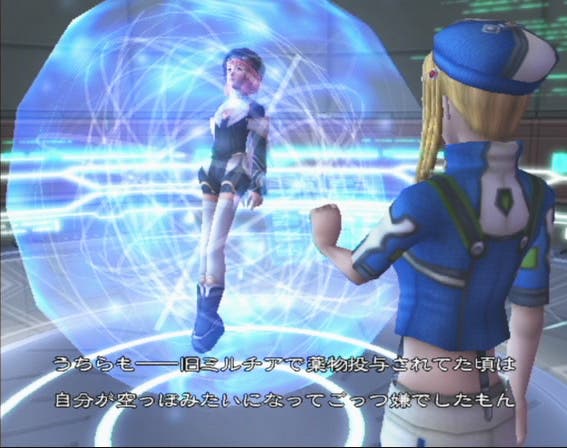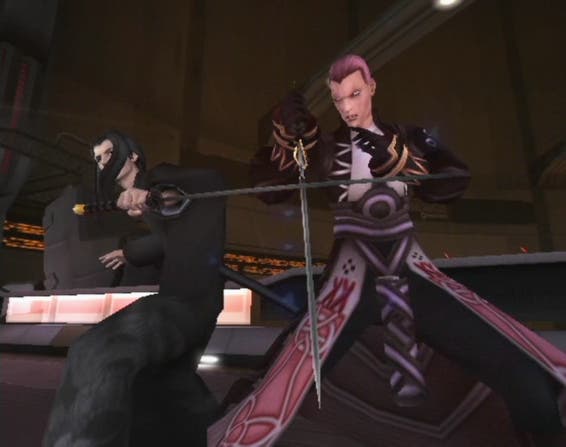Xenosaga Episode II: Jenseits von Gut und Bose
It's certainly a bit jenseits us.
Imagine lugging Tolstoy's giant novel War and Peace home in your satchel, the physical weight of its 1500 pages mirroring the life-enriching substance of the prose; an epic in the true - oft-misused - sense of the description.
Now envisage yourself settling down to start reading only to realise the first 20,000 words of characterisation, plot introduction and scenario setting are missing and you've been dropped right into the middle of a story you really know nothing about.
Hold that thought.
Xenosaga is not a household franchise name here in Europe. But in its homeland of Japan, the series and its illustrious creator, Tetsuya Takahashi, are famed for attempting to take the videogame adventure in a different direction. Remember those ghastly interactive movie games from the early nineties: pixel drivel such as Night Trap? Well this is what happened when that concept improved itself, married a Japanese RPG producer and then gave birth in space.
Xenosaga Episode II is the second instalment in what will allegedly be a six-part videogame/RPG anime opus set four thousand years in a future of spaceships and bionic soldiers. Savvy gamers who imported their RPGs in the PSone era might remember Squaresoft's wonderful Xenogears, an RPG to rival Final Fantasy VII for critical acclaim. The Xenosaga series is a prequel to that game although now developer Monolith Software works for Namco.

The scale of the series is as gigantic as one might expect when you start to place six full-length RPGs back to back: every aspect of the sprawling character roster, overarching scenario, cultural reference and artsy camera angle just a tiny nuance on the vision's sprawling canvas.
So on the one hand, this is a very interesting game.
Still holding Tolstoy in the other hand? Good. As if trying to grab a hold on this behemoth of a story wasn't hard enough, you likely won't have played the first game, having only been released in Japan and America three years ago. So, in Xenosaga Episode II you are shoved into the middle of a sprawling narrative, its plot tentacles stretching off into a foggy distance in all directions. And to make matters worse, you've missed out on the first ten chapters.
The War and Peace analogy works as both it and Xenosaga Episode II are largely non-interactive: you respond to what is presented to you, but that's mainly it. Between them, Xenosaga 1 and 2 allegedly have over 30 hours of cut-scenes: the equivalent of 20 full-length 90-minute Hollywood blockbusters strung together in a narrative line. The traditional 'explore and fight' RPG gameplay really only serves as a means to draw lines to link the drama; it's videogaming turned on its head so you'd better get comfortable and order in the pizza.

The sense of confusion you'll no doubt experience when diving into this game is offset if you buy the special edition of Xenosaga Episode II, which comes with two bonus DVDs containing all the cut-scenes from the first game. If you want to get to grips with the Xenosaga universe then it is probably worth sitting down and watching through the bonus DVDs first as this game picks up right where the first title finishes, but that's some frightening background reading just to play a videogame.
Still, it's a bad analogy, because, while War and Peace actually is a classic, meaningful and significant story, Xenosaga, with its Nietzschen taglines, merely thinks it is.
Rather, it's a soap opera of an RPG set in space. The story centres around the exploits of unlikely heroine Shion Uzuki, a geeky engineer, and her ragtag band of supporting friends (bionic femme-fatale, KOS-MOS, diminutive gun-slinger Chaos, cutesy rag doll MOMO and grave-faced Ziggy), as they are thrust into a vast battle to prevent the powerful Zohar weapon from falling in to the wrong hands, the future seesawing on their success or failure.
The game is filled with long words, long-windedness and a liberal sprinkling of historical and contemporary cultural references that might make it look clever at a glance, but really just dress the straightforward to look high-brow. Underneath the showy dialogue, this is really just a standard RPG with hit-points, super-deformed character design, field exploration and hit-X-on-everything gameplay bolted on to a movie.

That's not to say it isn't good: there are excellent set-pieces, deep characterisation and an involved storyline. Enemies are visible on the field a la Chrono Trigger, eliminating randomness and the difficulty level has been set high to provide a challenge and a thrill to those sections you actually play.
There are a number of changes from the first game: character designs have been sexed-up and the main story and countless flashbacks are presented in a more straightforward way. In terms of the battle mechanic, surprisingly, weapons, armor, accessories and money are all gone. You can still level characters up but the key way to develop them into unique fighters is through unlocking skills. Each character has 112 skill slots, divided into four skill levels and classes, so there is dizzying scope for customisation and this freedom works really well. Some skills are equipped while others automatically take effect once mastered by the respective character and micromanagement is the key to balancing your team.
Characters can forgo their turns to boost and up the physical ante and a new attack option has been introduced to allow two characters to team up and perform a combination attack. Like in Final Fantasy X it's also now possible to chop and change your characters mid-fight, sending misplaced team members to the bench and calling up fresh muscle. In addition, there are three huge mecha robots which can piloted by your characters during key fights. This feature was in the first game as well but, again, it has been better implemented here and, although mecha battles are far fewer than the on foot variety, they are another welcome distraction.

The battle system revamp has been just what the game needed and it works extremely well. Combined with the high difficulty level, fights can be very exciting requiring fast reactions and good leadership to ensure victory.
Where Xenosaga Episode II compensates for the cut-scene/playable game is with it's side quests which are expansive and, technically, outlast the main game in terms of length. For example, the "G2 campaign" consists of 36 optional Herculean tasks to complete ranging from key battles, learning memory sequences and item fetching exercises. There are even four bonus dungeons for those who want to squeeze even more gameplay out of it.
Xenosaga 2, is a big commitment for any gamer. If you want to get the most out of the game you're looking at weeks of concentrated staccato playing/watching/playing/watching as you work your way through the huge narrative arc. But with four games still to come before the tale is told, there's no better time to get sucked in, and like all the best soap operas, this one will have your gripped and teetering on it's final cliffhanger in what really seems like no time at all.

